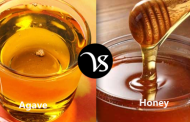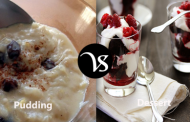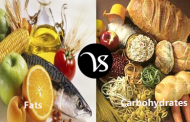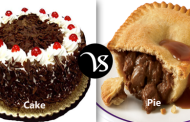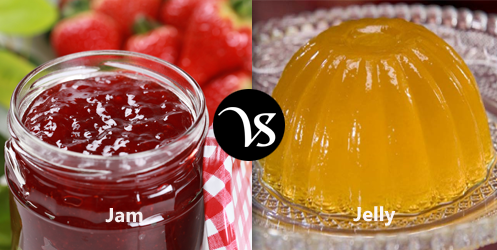 Jam:
Jam:
Jam is a fruit preserve which is made from crushing fruits and boiling it adding sugar. It is available in various fruit flavors. The texture of jam is thick and rough. It is mostly used as a spread in breads.
Jelly:
Jelly is a soft food made by boiling fruit juice and sugar. It is found in various tastes, flavors and choices. It has smooth texture. It is elastic or gel in consistency. It is served cold as a dessert.
Differences:
| Basis | Jam | Jelly |
|---|---|---|
| Definition | Preserve, jelly, conserve (www.collinsdictionary.com) | A fruit-flavoured dessert made by warming and then cooling a liquid containing gelatin or a similar setting agent in a mould or dish so that it sets into a semi-solid, somewhat elastic mass (www.oxforddictionaries.com) |
| Synonyms | Squeeze, pack, cram, squeeze, ram | Preserve, coagulate, conserve, gluten, gel |
| Antonyms | Unpack, abandoned, clear, aimless, actuate | Liquefy, thaw, melt off, deliquesce, fuse, flux |
| History | The earliest cookbook, called Of Culinary Matters, which dates back to 1st century Rome, contained recipes for making jam. It was part of the diet in the countries of the Middle East where there was an abundance of sugar that grew naturally. | Jelly has been eaten since Egyptian times. It is mentioned in early Anglo-Saxon recipe books. |
| Word origin | The word jam was originated from Early 18th century: probably symbolic; compare with and cram. | The word jelly was originated from Late Middle English: from Old French gelee ‘frost, jelly’, from Latin gelata ‘frozen’, from gelare ‘freeze’, from gelu ‘frost’. |
| Physical form | Jam is thick, paste form that has fruit chunks in it. | Jelly has a clear or translucent form, which is held together. It jiggles when shaken. |
| Texture | Lumpy | Smooth |
| Usage | Spread, topping for desserts | Dessert, spread |
| Pronunciation |
|
|
| Advantages/Benefits | Its advantages are:
|
Its advantages are:
|
| Disadvantages | Its disadvantages are:
|
Its disadvantages are:
|
| Example in Sentence |
|
|


